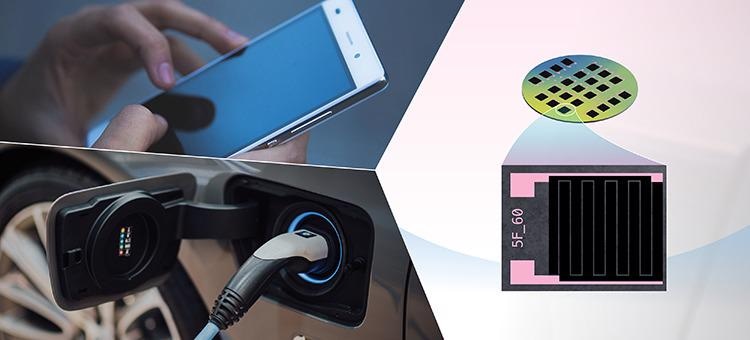Micro-supercapacitors could transform the way batteries are used by extending their lifespan and facilitating very fast charging. Manufacturers of products ranging from smartphones to electric cars are therefore making significant investments into research and development of these electronic parts.
 Micro-supercapacitors can increase the lifespan of batteries and reduce their charging time in products like smartphones and electric cars. The image shows a 2- inch wide silicon wafer with integrated micro-supercapacitors, manufactured using the CMOS-compatible process developed by Chalmers’ researchers. The wafer can be upscaled to a diameter of 8 inches to fit even more supercapacitor units. Image Credit: Illustration: Yen Strandqvist.
Micro-supercapacitors can increase the lifespan of batteries and reduce their charging time in products like smartphones and electric cars. The image shows a 2- inch wide silicon wafer with integrated micro-supercapacitors, manufactured using the CMOS-compatible process developed by Chalmers’ researchers. The wafer can be upscaled to a diameter of 8 inches to fit even more supercapacitor units. Image Credit: Illustration: Yen Strandqvist.
Currently, scientists at the Chalmers University of Technology, Sweden, have formulated a technique that signifies a discovery for how such supercapacitors can be made.
When discussing new technologies, it is easy to forget how important the manufacturing method is, so that they can actually be commercially produced and be impactful in society. Here, we have developed methods that can really work in production.
Agin Vyas, Study Lead Author and Doctoral Student, Department of Microtechnology and Nanoscience, Chalmers University of Technology
Supercapacitors comprise two electrical conductors divided by an insulating layer. They can store electrical energy and have numerous positive features compared to a standard battery, such as faster charging, more efficient energy distribution, and an extended lifespan without loss of performance, regarding the charge and discharge cycle.
When a supercapacitor is integrated with a battery in an electrically driven system, the lifespan of the battery can be prolonged – up to 4 times for commercial electric vehicles. Both for personal electronic devices and industrial technologies, the advantages for the end consumer could be enormous.
It would of course be very convenient to be able to quickly charge, for example, an electric car or not have to change or charge batteries as often as we currently do in our smartphones. But it would also represent a great environmental benefit and be much more sustainable, if batteries had a longer lifespan and did not need to be recycled in complicated processes.
Agin Vyas, Study Lead Author and Doctoral Student, Department of Microtechnology and Nanoscience, Chalmers University of Technology
Manufacturing a Big Challenge
Yet, in reality, present-day supercapacitors are too large for several applications where they could be beneficial. They have to be around the same size as the battery they are linked to, which is a hindrance to incorporating them in electric cars or mobile phones. Therefore, a large portion of present-day research and development of supercapacitors is focused on making them significantly smaller.
Agin Vyas and his colleagues have been involved in designing “micro” supercapacitors. These are so tiny that they can be placed on the system circuits which regulate various functions in mobile phones, electric motors, computers, and virtually all electronics that are in use at present. This solution is also referred to as “system-on-a-chip.”
One of the most crucial challenges is that the minimal units have to be mass-produced in such a way that they are well-matched with other components in a system circuit and can easily be customized for various areas of use. The new study shows a manufacturing process wherein micro-supercapacitors are combined with the most typical way of manufacturing system circuits (called CMOS).
We used a method known as spin coating, a cornerstone technique in many manufacturing processes. This allows us to choose different electrode materials. We also use alkylamine chains in reduced graphene oxide, to show how that leads to a higher charging and storage capacity.
Agin Vyas, Study Lead Author and Doctoral Student, Department of Microtechnology and Nanoscience, Chalmers University of Technology
“Our method is scalable and would involve reduced costs for the manufacturing process. It represents a great step forward in production technology and an important step towards the practical application of micro-supercapacitors in both everyday electronics and industrial applications,” Agin Vyas added.
A technique has also been formulated for making micro-supercapacitors of up to 10 different materials in one integrated manufacturing process, which means that properties can be effortlessly tailored to suit numerous diverse end applications.
Journal Reference:
Vyas, A., et al. (2021) Alkyl-Amino Functionalized Reduced-Graphene-Oxide–heptadecan-9-amine-Based Spin-Coated Microsupercapacitors for On-Chip Low Power Electronics. Physica Status Solidi. doi.org/10.1002/pssb.202100304.